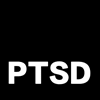www.psychspace.com心理学空间网
Let’s Talk Facts About Posttraumatic Stress Disorder
© Copyright 2005 American Psychiatric Association
What Is Posttraumatic Stress Disorder?
Posttraumatic stress disorder (PTSD) is a psychiatric disorder that can occur in people who have experienced or witnessed life-threatening events such as natural disasters, serious accidents, terrorist incidents, war, or violent personal assaults like rape. People who suffer from PTSD often relive the experience through flashbacks or nightmares, have difficulty sleeping, and feel detached or estranged.
The Facts
PTSD has often been misunderstood or misdiagnosed, even though the disorder has very specific symptoms. Although it was once thought to be mostly a disorder of war veterans who had been involved in heavy combat, researchers now know that PTSD also affects both female and male civilians, and that it strikes more females than males.
In some cases the symptoms of PTSD disappear with time, whereas in others they persist for many years. PTSD often occurs with—or may contribute to—other related disorders, such as depression, substance abuse, problems with memory, and other problems of physical and mental health.
Everyone who experiences trauma does not require treatment; some recover with the help of family, friends, or clergy. But many do need professional treatment to recover from the psychological damage that can result from experiencing, witnessing, or participating in an overwhelmingly traumatic event.
Symptoms
PTSD usually appears within three months of the trauma, but sometimes the disorder appears later. Symptoms for PTSD fall into three categories:
• Intrusion
• Avoidance
• Hyperarousal
INTRUSION
In people with PTSD, memories of the trauma reoccur unexpectedly, and episodes called "flashbacks" intrude into their current lives. This happens when sudden, vivid memories, accompanied by painful emotions, take over the person’s attention. Flashbacks may be so strong that individuals feel like they are actually re-living the traumatic experience or seeing it unfold before their eyes and in nightmares.
AVOIDANCE
Avoidance symptoms affect relationships with others: The person often avoids close emotional ties with family, colleagues, and friends. At first, the person may feel numb, have diminished emotions, and may only complete routine, mechanical activities. Later, when re-living the traumatic event, the individual may alternate between a flood of emotions caused by the flashback and an inability to feel or express emotions at all. A person with PTSD avoids situations or activities that are reminders of the original traumatic event.
The inability of a person with PTSD to work out grief, anger or fear from the traumatic event means the trauma can continue to affect the person’s behavior without them being aware of it. Depression is a common product of this inability to resolve painful feelings. Some people also feel guilty because they survived a disaster if others—particularly friends or family—did not.
HYPERAROUSAL
PTSD can cause individuals to act as if they are constantly threatened by the trauma that caused their illness. They can become suddenly irritable or explosive, even when unprovoked. They may have trouble concentrating or remembering current information, and, because of terrifying nightmares, may develop insomnia. This constant feeling that danger is near causes exaggerated startle reactions.
Finally, many people with PTSD also attempt to rid themselves of painful flashbacks, loneliness, and anxiety by abusing alcohol or other drugs to "self-medicate" or help them to dull or forget the pain and trauma temporarily. A person with PTSD may show poor control over his or her impulses and may be at risk for suicide.
Treatment for PTSD
Today, psychiatrists and other mental health professionals have good success in treating the very real and painful effects of PTSD. They use a variety of treatment methods to help people with PTSD to work through their trauma and pain.
Cognitive Behavior Therapy (CBT)focuses on correcting the painful and intrusive patterns of behavior and thought by teaching people with PTSD relaxation techniques and examining (and challenging) the mental processes that are causing the problem.
Exposure therapyuses careful, repeated, detailed imagining of the trauma (exposure) or progressive exposures to symptom “triggers” in a safe, controlled context to help the survivor face and gain control of the fear and distress that was overwhelming during the trauma. In some cases, trauma memories can be confronted all at once (flooding). For others, it is preferable to work up to the most severe trauma gradually or by taking the trauma one piece at a time (desensitization).
Psychodynamic psychotherapyfocuses on helping the individual examine personal values and how behavior and experience during the traumatic event affected them.
Family therapymay also be recommended because the behavior of spouse and children may result from and affect the individual with PTSD.
Discussion groups or peer-counseling groupsencourage survivors of similar traumatic events to share their experiences and reactions to them. Group members help one another realize that many people would have done the same thing and felt the same emotions.
Medicationcan help to control the symptoms of PTSD. The symptom relief that medication provides allows many patients to participate more effectively in psychotherapy when their condition may otherwise prohibit it.
Antidepressant medications may be particularly helpful in treating the core symptoms of PTSD either alone or in combination with psychotherapy.
Resources
For more information, please contact:
American Psychiatric Association (APA)
1000 Wilson Blvd.
Suite 1825
Arlington, VA 22209
703-907-7300
www.healthyminds.org
Anxiety Disorders Association of America (ADAA)
8730 Georgia Avenue
Suite 600
Silver Spring, MD 20910
240-485-1001
www.adaa.org
National Mental Health Association (NMHA)
2001 N. Beauregard Street
12th Floor
Alexandria, VA 22311
800-969-NMHA (6642)
www.nmha.org
International Society for Traumatic Stress Studies (ISTSS)
60 Revere Drive
Suite 500
Northbrook, IL 60062
847-480-9028
www.istss.org
One in a series of brochures designed to reduce stigmas associated with mental illnesses by promoting informed factual discussion of the disorders and their psychiatric treatments. This brochure was developed for educational purposes and does not necessarily reflect opinion or policy of the American Psychiatric Association. For more information, please visit www.healthyminds.org.
www.psychspace.com心理学空间网

